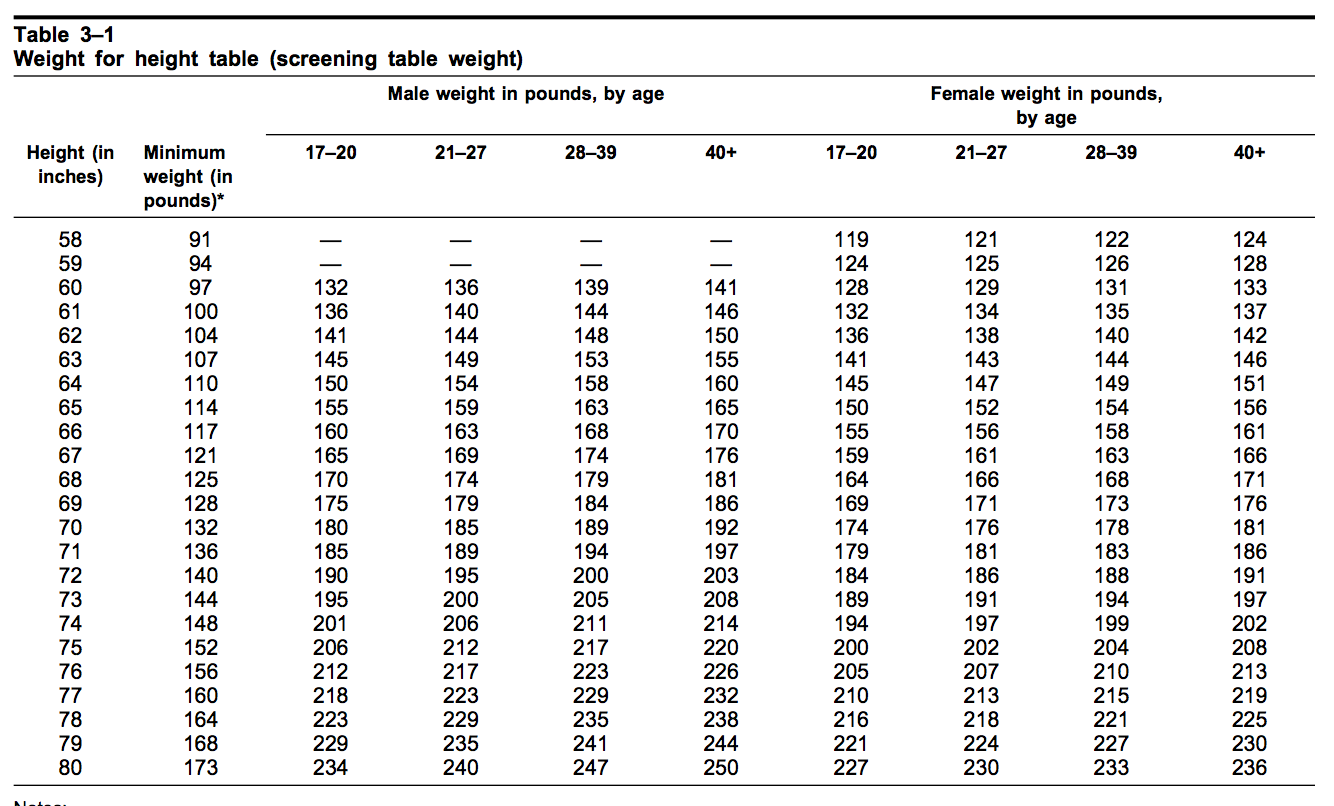In 2024, the United States Army continues to uphold strict height and weight standards to ensure that soldiers meet the physical demands of military service. These standards are crucial for maintaining operational readiness and overall health among soldiers. Whether you are a prospective recruit or an active-duty soldier, understanding these requirements is essential for your career in the Army.
The Army's height and weight standards are not just arbitrary numbers; they are based on extensive research to ensure that soldiers can perform their duties effectively. This article will delve into the specifics of the Army's height and weight standards for 2024, the rationale behind these standards, and the consequences of failing to meet them.
We will also explore how the Army measures height and weight, the importance of body composition, and tips for recruits to meet these standards. By the end of this article, you will have a thorough understanding of the Army's physical requirements and how to prepare for them effectively.
Table of Contents
- Overview of Army Height and Weight Standards
- Height Standards for Army Personnel
- Weight Standards for Army Personnel
- Understanding Body Composition
- How Height and Weight Are Measured
- Consequences of Failing to Meet Standards
- Tips for Meeting Height and Weight Standards
- Conclusion
Overview of Army Height and Weight Standards
The Army height and weight standards are designed to ensure that soldiers maintain an optimal level of fitness necessary for military operations. The standards vary based on age and gender, reflecting the different physiological characteristics of recruits and soldiers.
In 2024, the Army retains its commitment to fostering a fit and healthy force. Soldiers must meet these standards during their initial entry into the Army and throughout their careers to ensure they remain capable of performing their duties effectively.
Height Standards for Army Personnel
The Army has specific height requirements that all recruits must meet. These requirements are established based on percentile ranges that correspond to the general population. In 2024, the following height ranges apply:
- Male Soldiers: 60 to 80 inches (5 feet 0 inches to 6 feet 8 inches)
- Female Soldiers: 58 to 80 inches (4 feet 10 inches to 6 feet 8 inches)
These height standards ensure that all soldiers fit within a range that allows them to operate efficiently in various military roles.
Weight Standards for Army Personnel
In addition to height, the Army has established weight standards that vary depending on a soldier's age and gender. The following table outlines the maximum allowable weights for male and female soldiers:
| Gender | Age Group | Maximum Weight (lbs) |
|---|---|---|
| Male | 17-20 | 191 |
| Male | 21-27 | 199 |
| Male | 28-39 | 204 |
| Female | 17-20 | 164 |
| Female | 21-27 | 170 |
| Female | 28-39 | 175 |
Understanding Body Composition
The Army emphasizes not only weight but also the overall body composition of its soldiers. Body composition refers to the proportion of fat and non-fat mass in the body. A soldier's performance is not solely determined by weight; the ratio of muscle to fat plays a crucial role.
To assess body composition, the Army uses the Body Fat Percentage (BFP) method, which is calculated based on measurements of the neck and waist for males and the neck, waist, and hips for females. The following standards are applied:
- Male Soldiers: Maximum body fat percentage of 20%
- Female Soldiers: Maximum body fat percentage of 30%
Body composition standards aim to ensure that soldiers are fit enough to carry out their duties, reducing the risk of injury and enhancing performance.
How Height and Weight Are Measured
The Army follows a standard procedure for measuring height and weight to ensure consistency and accuracy. Here’s how the measurement process works:
- Height is measured without shoes using a stadiometer, ensuring that the soldier stands straight with their heels together, back straight, and head level.
- Weight is taken on a calibrated scale with standard clothing, ensuring that soldiers do not wear heavy outerwear or equipment during the measurement.
The Army conducts these measurements during initial entry processing and regularly thereafter to ensure compliance with the standards.
Consequences of Failing to Meet Standards
Failing to meet the Army's height and weight standards can have serious consequences for soldiers. If a soldier exceeds the maximum weight or body fat percentage, they may be flagged for a body composition program. The following outcomes may occur:
- Mandatory participation in a weight management program.
- Ineligibility for promotions or awards until standards are met.
- Potential administrative actions, including separation from service in extreme cases.
It is essential for soldiers to stay within these standards to maintain their career progression and overall standing in the Army.
Tips for Meeting Height and Weight Standards
For recruits and active-duty soldiers striving to meet the Army's height and weight standards, the following tips can help:
- Engage in regular physical training that includes both cardiovascular and strength training exercises.
- Maintain a balanced diet rich in fruits, vegetables, lean proteins, and whole grains.
- Stay hydrated and avoid excessive consumption of sugary beverages.
- Monitor your weight and body composition regularly to track progress.
- Seek guidance from a nutritionist or fitness trainer if needed.
Conclusion
Understanding the Army's height and weight standards for 2024 is crucial for anyone considering a career in the military. These standards are in place to ensure that soldiers are physically capable of meeting the demands of their roles.
By following the tips provided and maintaining a healthy lifestyle, soldiers can successfully meet these requirements and enhance their overall performance in the Army. If you have any questions or comments about the Army's height and weight standards, feel free to leave them below!
Thank you for reading, and we invite you to explore more articles to help you on your journey in the Army.




